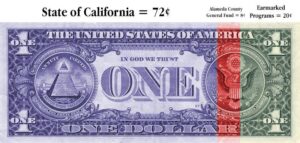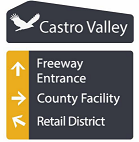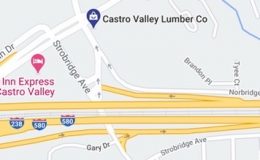Sales Tax and Castro Valley: Fireworks that Fizzle
- By : Brian Foster
- Category : Economic Development
- Tags: sales tax
If you thought that the addition of T.J.Maxx would bring lots of sales tax money into Castro Valley, well, you’d be wrong.
If you thought that a renovated and bustling Daughtrey’s Building would bring in lots of sales tax revenue into Castro Valley, well, you’d still be wrong.
The truth is that Castro Valley benefits almost nothing from increasing sales tax. Why? The short answer is that most of the sales tax revenue goes elsewhere. The long answer will be provided in a series of blog entries about how sales taxes work in California, how they benefit real cities in small ways, and how they barely benefit unincorporated areas at all.
First, a three-question test (answers provided below):
- What is the current sales tax rate in Castro Valley?
- How much of that sales tax stays in Alameda County?
- What portion of that sales tax is dedicated to Castro Valley?
You probably know that sales tax rates vary by region, county, and city within the State of California. Some states do not have sales taxes at all. Wyoming funds its schools primarily through leases of government property to miners and farmers. There is no one best way to fund government. In California, sales taxes became a more significant source of revenue for government, especially after Proposition 13 limited property tax revenues in 1978.
It might surprise you to learn that the money you pay to the cashier at the store for sales tax goes to the State of California first. The State then sends a small portion of it back to cities, counties, and special districts that have a right to their sliver of taxes. Unincorporated areas like Castro Valley receive no distribution of funds because there would be no one to send the check to! (Besides which, there are no boundaries that legally define “Castro Valley” as an entity.)
As of the summer of 2014, sales tax rates in California range from 7.5-10.0%, depending on where you live. The State of California imposes a minimum 7.5% rate, and voters in cities, counties, and special districts can add to the rate. In Castro Valley, the current sales tax rate is 9.0%, with 7.5% collected by the State, 0.5% going to Bay Area Rapid Transit (since 1970), 0.5% for Alameda County Measure A (health care), and 0.5% going to Alameda County Measure B (transportation).
That sounds complex, and it is. It is even more complex when you look at the State’s 7.5% portion, since the State sends 0.25% of that back to counties to support transportation, and it sends 0.75% back to cities (or counties, for unincorporated areas) for them to spend on anything they wish.
Put another way, if you went down to Merle’s Hallmark card store in the Village and spent $11.11, you would pay a sales tax of $1.00, for a total bill of $12.11. Of that $1.00 in sales tax, 72¢ would go to the State of California, 8¢ would be sent to Alameda County to be spent as the County wishes, and 20¢ would be spent on earmarked programs like BART, health, and transportation (rounding to the nearest penny). The graphic below illustrates this allocation of sales tax revenue.
How much of that 8¢ comes to Castro Valley? Legally, not one penny needs to be spent in Castro Valley. The five-member Alameda County Board of Supervisors can spend those funds anywhere in the county, and it does. The County’s primary functions include public safety (sheriff, courts, jail), health (hospitals, public health), and welfare (general assistance, family support). Only one County Supervisor, Nate Miley, represents Castro Valley, and the other four Supervisors have needs that they want met in their own districts.
While it is true that some portion of the 8¢ trickles down into Castro Valley, there is no requirement that any amount be spent here. Of course, the County Supervisors do spend some money in Castro Valley for things like roads, sheriff protection, etc., but there are no legal rights or claims to these funds. For cities, the story is entirely different: real cities get all 8¢ to spend in their own city as they wish.
As long as government funding remains constrained, as it has been since the passage of Proposition 13 in 1978, governments have focused their funding primarily on their core activities regardless of location. In short, of the 8¢ in sales tax revenue that might come to Castro Valley, it is likely that only a small fraction of that amount is actually spent in Castro Valley.
Think of other cities in Alameda County that host major County facilities: County headquarters in Oakland; courts in Alameda, Berkeley, Oakland, Hayward, Fremont, San Leandro, and Pleasanton; planning and building in Hayward; Santa Rita Jail in Dublin and the juvenile justice center in San Leandro; Highland Hospital in Oakland (among others). The greatest recent investment that the County has made in Castro Valley is the rather new, wonderful library. It is quite typical for counties to ignore investment in unincorporated areas.
While these government investments do not add to the property tax base (government properties are not taxed), they do contribute to the local economy and the sales tax base. They bring in jobs, visitors, construction, and maintenance. Every time you travel to another city to perform jury duty and purchase a book or magazine to while away your time, you are contributing to the host city’s sales tax base.
Future blog entries will explain various aspects of sales taxes in more detail. Among the topics discussed will be sales tax history, detailed breakdowns of the overall tax rate, tax rates in other areas, revenue amounts, collection and distribution of taxes, disputes among government entities, accounting, etc.



And the new Castro Valley Library was funded with nearly $14million dollars from the State Library Bond Act of 2000 not local taxpayers per se.
Hi Brian,
I would say that is a pretty fair assessment of our sales tax dollars. This is one financial reason I have supported Castro Valley Cityhood 100%.
Another reason why cityhood is attractive, we CV citizens represent about 20% of the vote for our 1 supervisor and 0% for the other 4 Supervisors. The other 80% of the vote for our supervisor comes from Oakland, Pleasanton, Ashland, Cherryland and Fairview.
It is not likely that I will see, my community, Castro Valley become a city in my lifetime. The distribution of funds in Sacramento would have to change before it would be reasonable for Castro Valley to become its own city.
Hi Sylvia,
It was sure exciting to be at the library when State Treasurer Phil Angelides gave the $13.9 million to Supervisor Miley for the great library that we all enjoy. It was the work of the CV citizens working with Senator Ellen Corbett that made this happen. Thank you Sylvia, for your many years of work on the Library Committee.
Go CV! – Bob Swanson, CV resident
And go Bob Swanson! Does anyone ever thank you for keeping in touch with everyone and everything in town, written, texted, facebooked or in person?
I thank him every time I see him. If it wasn’t for Bob, I’d still have a drug dealer living next door to me. Once she left, we got our old neighborhood back and now I live on one of the best/happiest streets in C.V. Thank you again Bob!!!!
Thank you for this well researched blog, Brian.It is so important to have a real understanding of where our tax dollars go. Too many assumptions are made with our complicated governance structure in Unincorporated Alameda County.